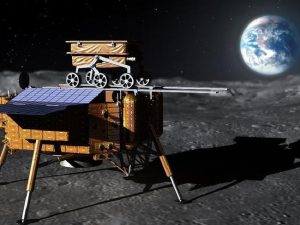
As part of his six week-long tour of Asian countries, King Salman bin Abdulaziz Al Saud of Saudi Arabia has presided over a major space agreement between his Kingdom and Asia’s leading space power, China.
This prominent agreement is a Memorandum of Understanding (MoU) between the King Abdulaziz City of Science and Technology (KACST) and the China National Space Administration (CNSA) for Saudi Arabia to contribute to and participate in the Chinese-led Chang’e-4 Moon mission, scheduled to be launched in 2018.
The Chang’e-4 mission was originally supposed to be launched in 2015, but was delayed due to changes in the mission’s design. The Chang’e-4 mission will consist of a Lunar lander and rover, and will land on the dark side of the Moon, potentially near the Aitken Basin. The lander and rover will not be launched until a communications relay satellite is launched and placed at the Earth-Moon L2 position, one of the so-called Lagrange Points between the Earth and Moon.
A Lagrange Point is,”a location in space where the combined gravitational forces of two large bodies, such as Earth and the sun or Earth and the moon, equal the centrifugal force felt by a much smaller third body. The interaction of the forces creates a point of equilibrium where a spacecraft may be “parked” to make observations,” according to Elizabeth Howell, writing in Space.com in 2015.
Chang’e-4 is also the first Chinese space mission that uses private investments from individuals and organisations in order to accelerate the development and completion of the mission, as well as establishing ties between the Chinese government and the private sector.
At the time of reporting it is not known whether KACST is one of these private investors in Chang’e-4, or whether Saudi involvement will be technical and scientific in nature.
King Salman’s extensive tour of Asia, accompanied by over 1,000 Saudi business executives, advisors, and courtiers, has resulted in an estimated U.S.$65 billion worth of economic agreements between the Kingdom and China alone, as well as other lucrative deals between Saudi Arabia and Japan, Malaysia, Indonesia, Brunei, and the Maldives. Saudi Arabia is also keen to participate in the Chinese infrastructure initiative for Eurasia and the Indian Ocean, the so-called One Belt, One Road (OBOR) initiative.
The tour is part of a larger Saudi effort to broaden the Kingdom’s economic and strategic partnerships as it attempts to diversify its largely oil-dependent economy. The Saudi Arabian Vision 2030 is the roadmap for this effort, and creating a high-technology research and industrial sector – such as space and satellite programmes – is an important priority for Riyadh.
The Chang’e-4 agreement between Saudi Arabia and China also broadens the number of major space powers seeking to cooperate with Middle East countries in space. Countries such as Saudi Arabia, the United Arab Emirates, Iran, Israel, and Turkey are cooperating in one form or another with the space agencies and satellite companies from China, Europe, India, Japan, Russia, South Korea, and the United States.
Original published at: https://spacewatch.global/2017/03/saudi-arabia-contribute-chinas-change-4-moon-mission/
 SpaceWatch.Global An independent perspective on space
SpaceWatch.Global An independent perspective on space

